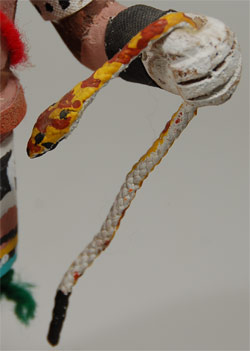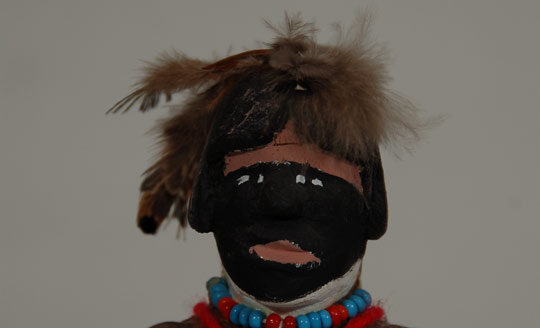Hopi Snake Dancer with Snake [SOLD]
+ Add to my watchlist Forward to Friend
- Category: Traditional
- Origin: Hopi Pueblo, Hopituh Shi-nu-mu
- Medium: cottonwood root, paint, feathers, beads, yarn
- Size: 9-3/8” tall
- Item # C3452A SOLD
 At the end of the nineteenth century, very few tourists had ever seen the Hopi Snake Dance. Many, however, had heard tales of a dramatic ritual that only occurred every other year in isolated Indian villages in Arizona. This religious ceremony that Victorian society found so horrifying—and so fascinating—soon grew into a symbolic representation of “Indian Country” in the Southwest.
At the end of the nineteenth century, very few tourists had ever seen the Hopi Snake Dance. Many, however, had heard tales of a dramatic ritual that only occurred every other year in isolated Indian villages in Arizona. This religious ceremony that Victorian society found so horrifying—and so fascinating—soon grew into a symbolic representation of “Indian Country” in the Southwest.
The Passenger Department of the Santa Fe Railway played upon sensationalist, tourist visions of American Indians when it published Walter Hough’s travel guide to The Moki Snake Dance. The guide describes Hough’s text as a “popular account of that unparalleled dramatic pagan ceremony” with “incidental mention of their life and customs.”
Hough’s report focuses on this one unusual aspect of the Hopi religion, emphasizing it and subordinating the normal day-to-day activities of Pueblo life of the Hopi. The tourist industry promoted this contradictory view of Southwest Indians. On the one hand, the Hopi were shown as a peaceful people, who made elegant, hand-crafted objects. But on the other hand, the Snake Dance proved that these peoples were true “savages” at heart, in spite of their peaceful appearances. This duality captured the imaginations of elite visitors and provided a popular motivation for treks to the Southwest.
Today, the Hopi Snake Dance is closed to all non-natives. There was a time before the 1990s when tourists were allowed to witness the Snake Dance, but no longer. There was also a time when Hopi carvers would not carve Snake Dancers, but that has relaxed somewhat now and some carvers will make them.
 This Snake Dancer figure was carved by Logan Dallas (1900-1990s). Dallas was an active carver from around the 1920s to the 1970s. He lived at the village of Oraibi on Third Mesa, and then later lived in his daughter’s house at Moenkopi, also on Third Mesa. He was born before the split at Old Oraibi, where the village split between the Traditionalists and those who accepted the Government changes.
This Snake Dancer figure was carved by Logan Dallas (1900-1990s). Dallas was an active carver from around the 1920s to the 1970s. He lived at the village of Oraibi on Third Mesa, and then later lived in his daughter’s house at Moenkopi, also on Third Mesa. He was born before the split at Old Oraibi, where the village split between the Traditionalists and those who accepted the Government changes.
Dallas carved his dolls from personal knowledge as he remembered them from the early days at Hopi before influence of non-Indians began to appear in the guise of traders and tourists. His dolls are accurately presented and traditionally carved. He used a pocket knife, not any electric tools. This carving is a wonderful presentation of a Hopi Snake Dancer. He carries a snake in his left hand and feathers in his right. A nice array of feathers caps his head and he has a bead necklace representing turquoise and coral.
Condition: very good condition
Provenance: from the collection of Chuck and Jan Rosenak, collector of Native art and authors of books on Navajo folk art.
Reference and Recommended Reading: The Moki Snake Dance by Walter Hough, PhD. Published by the Passenger Department of the Santa Fe, 1901. A reprint published by Avanyu Publishing, Albuquerque, is available as a complimentary addition to the purchase of this doll.

- Category: Traditional
- Origin: Hopi Pueblo, Hopituh Shi-nu-mu
- Medium: cottonwood root, paint, feathers, beads, yarn
- Size: 9-3/8” tall
- Item # C3452A SOLD



